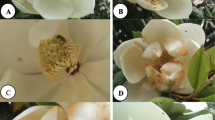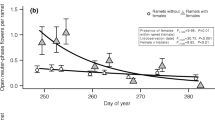Abstract
The reproductive characteristics and pollination system of Rhododendron semibarbatum were investigated at two sites in Honshu, Japan. This species is protandrous, partially self-incompatible at postzygotic stages, and requires outcrossing via pollinator visitation for effective seed production. The effective pollinators were two bumblebee species: males of Bombus ardens at Miyama, and workers of Bombus honshuensis at Agematsu. The flowers possess two staminodes ornamented with whitish hairs, which do not reflect UV light, on the filaments. Nectar was secreted continuously during the flowering period, and nectar production rate differed between the sites. Visitation by B. ardens males was more frequent and varied among and within days, whereas that by B. honshuensis workers was less frequent and constant throughout the observation period. A single visit by a B. ardens male was more effective for seed production than visitation by a B. honshuensis worker, resulting in pollen limitation in the latter case. Differences in resource requirements between the two pollinators, representing different castes, might affect their behavior, resulting in B. ardens males contributing to more effective seed production.






Similar content being viewed by others
References
Ackerman JD, Masler MR, Lu KL, Montalvo AM (1982) Food-foraging behaviour of male Euglossini (Hymenoptera: Apidae): vagabonds or trapliners. Biotropica 14:241–248
Alcock J, Alcock JP (1983) Male behaviour in two bumblebees, Bombus nevadensis auricornus and B. griseocollis (Hymenoptera: Apidae). J Zool 200:561–570
Cruden RW (2000) Pollen grains: why so many? Plant Syst Evol 222:143–165
Davis AR (1997) Pollination efficiency of insects. In: Shivanna KR, Sawhney VK (eds) Pollen biotechnology for crop production and improvement. Cambridge University Press, Cambridge, pp 87–120
Escaravage N, Pornon A, Doche B, Till-Bottraud I (1997) Breeding system in an alpine species: Rhododendron ferrugineum L. (Ericaceae) in the French northern Alps. Can J Bot 75:736–743
Escaravage N, Flubacker E, Pornon A, Doche B, Till-Bottraud I (2001) Stamen dimorphism in Rhododendron ferrugineum (Ericaceae): development and function. Am J Bot 88:68–75
Heywood VH (1993) Flowering plants of the world (updated edn). Oxford University Press, New York
Ito M (1991) Taxonomy, ecology and distribution of Japanese bumblebees. In: Heinrich B (eds) Bumblebee economics (In Japanese) (translated by Inoue T, Kato M, Kakutani T, Itino T). Bun-ichi Shuppan, Tokyo, pp 258–291
Jennersten O, Morse DH, O’Neil P (1991) Movement of male and worker bumblebees on and between flowers. Oikos 62:319–324
Kakutani T (1993) Nectar secretion patterns of flowers and nectar utilization patterns by insect visitors. In: Inoue T, Kato M (eds) Co-evolution of flower and pollinator (in Japanese). Heibonsha, Tokyo, pp 79–102
Kudo G (1993) Relationship between flowering time and fruit set of the entomophilous alpine shrub, Rhododendron aureum (Ericaceae), inhabiting snow patches. Am J Bot 80:1300–1304
Lunau TDK (2000) The ecology and evolution of visual pollen signals. Plant Syst Evol 222:89–111
Ng SC, Corlett RT (2000) Comparative reproductive biology of the six species of Rhododendron (Ericaceae) in Hong Kong, South China. Can J Bot 78:221–229
Nilsson LA (1998) The evolution of flowers with deep corolla tubes. Nature 334:147–149
Medel R, Valiente A, Bott-Mahan C, Carvallo G, Pérez F, Pohl N, Navaaro L (2007) The influence of insects and hummingbirds on the geographical variation of the flower phenotype in Mimulus luteus. Ecography. doi: 10.1111/j.2007.0906-7590.05175.x
Mejías JA, Arroyo J, Ojeda F (2002) Reproductive ecology of Rhododendron ponticum (Ericaceae) in relict Mediterranean populations. Bot J Linn Soc 140:297–311
Palser B, Rouse JL, Williams EG (1992) A scanning electron microscope study of the pollen tube pathway in pistils of Rhododendron. Can J Bot 70:1039–1060
Proctor M, Yeo P, Lack AJ (1996) The natural history of pollination. Timber Press, Portland
Suzuki K, Dohzono I, Hiei K (2007) Evolution of pollinator generalization in bumblebee-pollinated plants. Plant Species Biol 22:141–159
Thompson JN (2005) The geographic mosaic of coevolution. University of Chicago Press, Chicago
Torchio PF (1974) Mechanisms involved in the pollination of Penstemon visited by the masarid wasp, Pseudomasaris vespoides (Cresson). Pan-Pac Entomol 50:226–234
Ushimaru A, Watanabe T, Nakata K (2007) Colored floral organs influence pollinator behavior and pollen transfer in Commelina communis (Commelinaceae). Am J Bot 94:249–258
Walker-Larsen J, Harder LD (2001) Vestigial organs as opportunities for functional innovation: the example of the Penstemon staminode. Evolution 55:477–487
Waser NM, Campbell DR (2004) Ecological speciation in flowering plants. In: Dieckmann U, Doebeli M, Metz JAJ, Tautz D (eds) Adaptive speciation. Cambridge University Press, Cambridge, pp 264–277
Washitani I, Suzuki K, Kato M, Ono M (1997) Bumblebee handbook (in Japanese). Bun-ichi Shuppan, Tokyo
Williams NH, Dodson CH (1972) Selective attraction of male euglossine bees to orchid floral fragrances and its importance in long distance pollen flow. Evolution 26:84–95
Wyatt R (1983) Pollinator-plant interactions and the evolution of breeding systems. In: Real L (ed) Pollination biology. Academic, London, pp 51–95
Yamazaki T (1989) Ericaceae. In: Satake Y et al (eds) Wild flowers of Japan, woody plants II. Heibonsha, Tokyo, pp 122–156
Yamazaki T (1996) A revision of the genus Rhododendron in Japan, Taiwan, Korea and Sakhalin. Tsumura Laboratory, Tokyo
Acknowledgments
We thank J. Arai for his help in locating suitable field sites, A. Shimizu for identification of insects and M. Wakabayashi, H. Kato and N. Fujii for encouragement and comments on this study, and J. Yokoyama and Y. Takami for their critical reading of the manuscript. This work was partly supported by the Fujiwara Natural History Foundation.
Author information
Authors and Affiliations
Corresponding author
Electronic supplementary material
Below is the link to the electronic supplementary material.
10265_2008_155_MOESM1_ESM.doc
Table S1. Nectar volume (μL) and nectar sucrose (mg) produced by the 1st, 2nd and 3rd day’s flowers after anthesis. Mean ± 1SD (N of flowers) is shown. (DOC 45 kb)
Rights and permissions
About this article
Cite this article
Ono, A., Dohzono, I. & Sugawara, T. Bumblebee pollination and reproductive biology of Rhododendron semibarbatum (Ericaceae). J Plant Res 121, 319–327 (2008). https://doi.org/10.1007/s10265-008-0155-y
Received:
Accepted:
Published:
Issue Date:
DOI: https://doi.org/10.1007/s10265-008-0155-y




